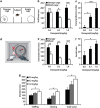Acetylcholine elevation relieves cognitive rigidity and social deficiency in a mouse model of autism
- PMID: 24096295
- PMCID: PMC3924518
- DOI: 10.1038/npp.2013.274
Acetylcholine elevation relieves cognitive rigidity and social deficiency in a mouse model of autism
Abstract
Autism spectrum disorders (ASD) are defined by behavioral deficits in social interaction and communication, repetitive stereotyped behaviors, and restricted interests/cognitive rigidity. Recent studies in humans and animal-models suggest that dysfunction of the cholinergic system may underlie autism-related behavioral symptoms. Here we tested the hypothesis that augmentation of acetylcholine (ACh) in the synaptic cleft by inhibiting acetylcholinesterase may ameliorate autistic phenotypes. We first administered the acetylcholinesterase inhibitor (AChEI) Donepezil systemically by intraperitoneal (i.p.) injections. Second, the drug was injected directly into the rodent homolog of the caudate nucleus, the dorsomedial striatum (DMS), of the inbred mouse strain BTBR T+tf/J (BTBR), a commonly-used model presenting all core autism-related phenotypes and expressing low brain ACh levels. We found that i.p. injection of AChEI to BTBR mice significantly relieved autism-relevant phenotypes, including decreasing cognitive rigidity, improving social preference, and enhancing social interaction, in a dose-dependent manner. Microinjection of the drug directly into the DMS, but not into the ventromedial striatum, led to significant amelioration of the cognitive-rigidity and social-deficiency phenotypes. Taken together, these findings provide evidence of the key role of the cholinergic system and the DMS in the etiology of ASD, and suggest that elevated cognitive flexibility may result in enhanced social attention. The potential therapeutic effect of AChEIs in ASD patients is discussed.
Figures





References
-
- Arnold H, Burk J, Hodgson E, Sarter M, Bruno J. Differential cortical acetylcholine release in rats performing a sustained attention task versus behavioral control tasks that do not explicitly tax attention. Neuroscience. 2002;114:451–460. - PubMed
-
- Association AP, DSM-IV 2000. APATF on (American Psychiatric Pub). Diagnostic and statistical manual of mental disorders: DSM-IV-TR.
-
- Avale ME, Chabout J, Pons S, Serreau P, Chaumont FD, Olivo-Marin J-C, et al. Prefrontal nicotinic receptors control novel social interaction between mice. FASEB J. 2011;25:2145–2155. - PubMed
Publication types
MeSH terms
Substances
LinkOut - more resources
Full Text Sources
Other Literature Sources
Molecular Biology Databases
Miscellaneous

